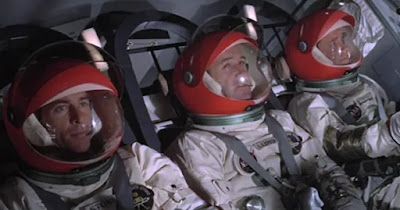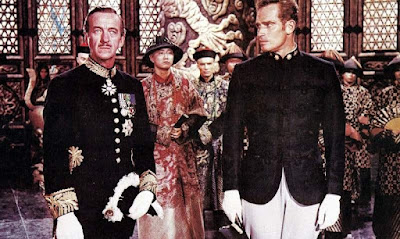Can we go back to the kind of air travel depicted in The High and the Mighty? No, not the part where the engines start failing and everyone has to start rethinking whether their life has turned out as they had hoped. Not that, no. Just the part where there are only seventeen passengers and big, wide seats and hot food cooked on the plane. I mean, I could do without the smoking on the plane, but the rest of it looks awfully luxurious compared to the cramped seating of contemporary flights. Of course, that’s not the point of the movie at all because this is a doomed flight from Honolulu to San Francisco, and everyone on board has some kind of issue that they’re grappling with that requires them to become quickly introspective. With a 2.5-hour running time, The High and the Mighty has plenty of space to share something about everyone on the plane. Even when each guest checks in at the desk in Honolulu, we get a little bit of insight into what their character is like. John Wayne, the primary star of this all-star cast, is a pilot haunted by the plane crash that killed his wife and son; we get some pretty vivid flashbacks of that event. In fact, we get flashbacks into the lives of several of the people on the plane, just enough to give us a taste of their lives on the ground. We have a couple who have been on their honeymoon and seem determined to join the Mile High Club even though they’re sitting in the first row of the cabin in full view of the other passengers and frequent view of the crew members in the cockpit. Another couple, Phil Harris and Ann Doran, have had a series of misadventures on their trip, and the issues with the plane seem destined to continue their bad luck. The great Laraine Day plays Lydia Rice, an heiress married to a man she doesn’t support emotionally. The rest of the players seem to represent particular stereotypes. For example, a young Korean woman on the plane keeps talking about badly she speaks and writes English even though the letter she’s writing to her brother is poetic. A painter named Flaherty is a scientist with regrets about his role in developing missiles. Another passenger is horribly afraid of crashes, and another one is terminally ill and treated very tenderly by the rest of the people on the plane. Two of the performers did get attention from the Academy Awards, and both seem to play a variation of the same role: the aging ingénue who has to face up to changes in her life. The first, Jan Sterling, plays the winner of a magazine’s popularity contest who’s on her way to meet her potential fiancé for the first time, and the second, Claire Trevor, plays an aging party girl who gets chummy very quickly with David Brian’s Ken Childs, a playboy accused of having an affair with the wife of another passenger. There’s even a young boy on board flying by himself from his father in Honolulu to his mother in San Francisco. Yes, it’s all a bit Peyton Place in the sky, and it’s clear this film heavily influenced later movies like Airport. Even the crew members have their issues. Robert Stack plays the pilot who is very experienced and has a sense that something might be wrong with the plane almost from takeoff, but he freezes when he needs to act. Willy Brown plays navigator Lenny Wilby, who doesn’t seem willing to admit to himself (or anyone else, for that matter) that he’s married to a very unfaithful woman who sounds like she might be drunk a lot of the time and not especially loving toward her husband. We have lots of confessions that come to light and many moments of coming to terms with their potential deaths as the film progresses and the problems with the plane seem to keep increasing. We get lots of shots of the pilots in the cockpit talking to the people on the ground trying to figure out how to rescue the passengers and crew, and the tension does begin to mount more heavily and effectively in the last half hour or so. Are they going to make it to the coast and a landing strip? Would the filmmakers really kill off all of these stars, including John Wayne? How did that kid sleep through all of the drama that was happening on board, even the sequence where everyone throws their luggage out of the rear door in order to lighten the load and save some gas? And he slept through the tense moments when the jealous husband tries to shoot Childs with a gun? That’s a very good sleeper. The High and the Mighty was filmed in widescreen CinemaScope, and the movie’s cinematography is truly beautiful. It’s great at capturing what it’s like to be on a plane, especially what it’s like to see so much of the world out of the small windows of a plane. The plot is certainly melodramatic and verges on becoming a soap opera, but we get enough insight into almost everyone on the plane to have a little bit of genuine empathy for almost all of them.
Oscar Win: Best Scoring of a Dramatic or Comedy Picture
Other Oscar Nominations: Best Director (William Wellman), Best Actress in a Supporting Role (Jan Sterling and Claire Trevor), Best Film Editing, and Best Original Song (“The High and the Mighty”)


















